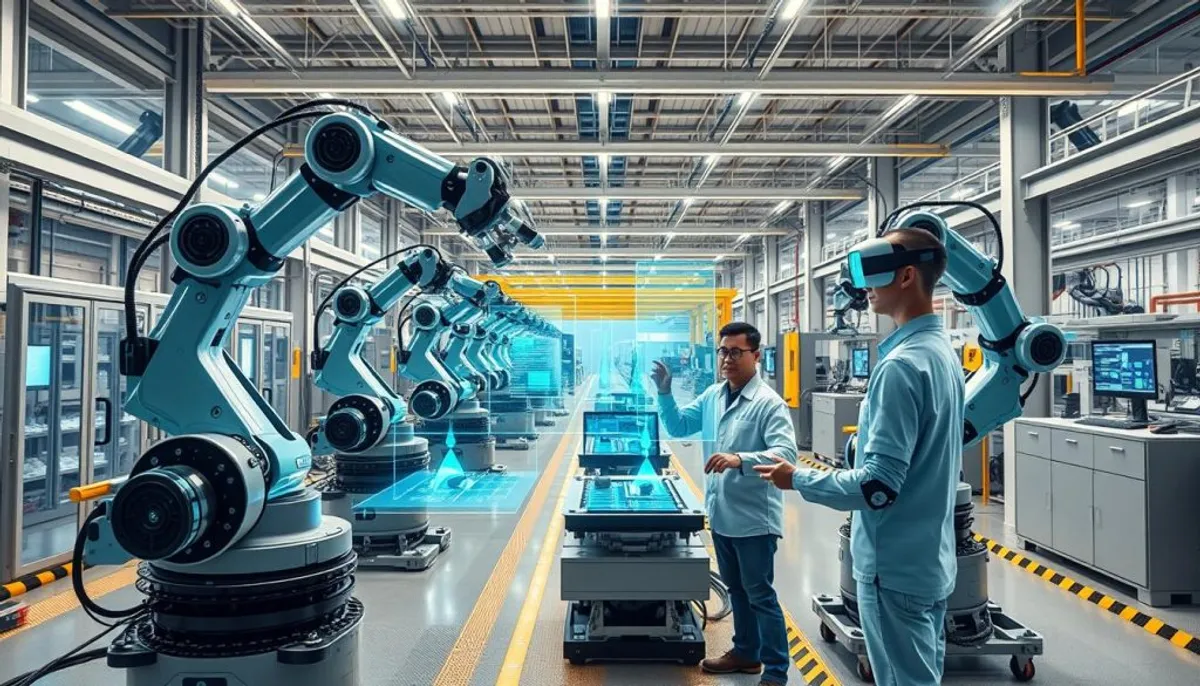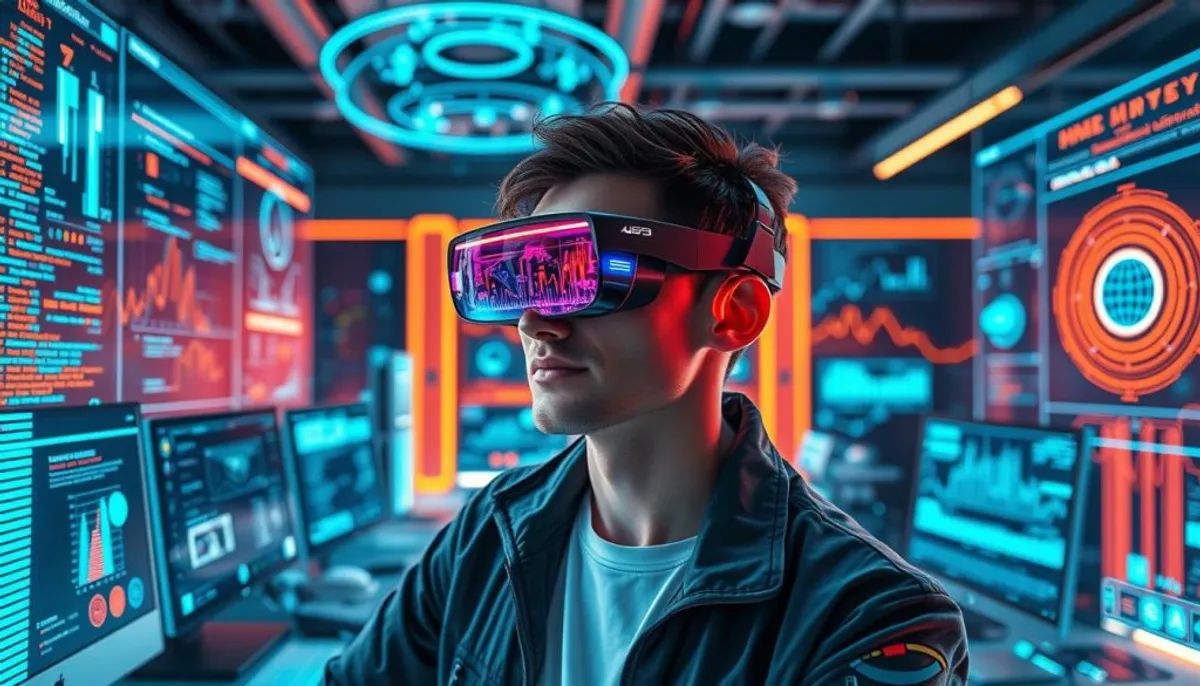Augmented reality (AR) is revolutionizing our perception of reality. It overlays digital content onto our physical environment, blending the virtual with the tangible. The AR market is poised for exponential growth, projected to surge from $32.1 billion to over $300 billion by the 2030s. This trajectory underscores the escalating importance of AR technology in our everyday lives and professional endeavors.
Automated AR is at the forefront of this transformation. It enables hands-free and intelligent AR experiences, significantly enhancing operational efficiency across various sectors. For instance, in manufacturing, AR can address the impending shortage of 2.4 million jobs by 2028, attributed to skill deficits. By facilitating rapid and error-reduced training, AR is poised to redefine workforce development.

In the retail domain, AR introduces a novel paradigm for employee training. It empowers staff to practice in simulated environments that mimic real-world scenarios, fostering proficiency without the risk of on-the-job errors. This approach not only enhances skill levels but also minimizes operational mistakes.
Even stalwarts like Boeing are leveraging AR to streamline processes and reduce errors. By visualizing wire placements, they expedite their operations. Such applications illustrate AR’s versatility and its potential to transform numerous industries.
Key Takeaways
- AR market expected to reach $300 billion by 2030s
- Automated AR improves efficiency across industries
- AR helps bridge the skills gap in manufacturing
- Retail uses AR for risk-free employee training
- 70% of experts believe AR will be common within 5 years
- 99% of companies with AR plans are ready to adapt
Understanding the Evolution of Augmented Reality Technology
Augmented reality technology has undergone a significant transformation since its inception. The AR history traces back to the 1960s, when Ivan Sutherland introduced the “Sword of Damocles,” the first AR head-mounted display. This innovation marked the start of a new digital interaction era.
Historical Development and Milestones
The evolution of AR innovations has been nothing short of remarkable. In 2008, BMW was the first to integrate AR into magazine advertising. The real turning point came in 2016 with Pokemon Go, which garnered over 100 million downloads, bringing AR into the mainstream. This success was soon followed by IKEA’s AR app in 2017, enabling customers to virtually see furniture in their homes.
Current Market Size and Growth Projections
The growth of the AR market has been nothing short of exponential. The release of AR development kits by tech giants like Apple and Google in 2018 sparked a surge in applications. The e-commerce sector is rapidly embracing AR, with businesses integrating it into mobile apps for virtual try-ons of products such as jackets and jewelry.
Key Industry Players and Innovations
At the forefront of AR innovations are companies like Snapchat, which introduced AR filters in 2015, followed by Facebook and Instagram. In healthcare and the military, AR training simulators are revolutionizing educational resources. The future of augmented reality technology appears promising, with ongoing research into AR-enabled contact lenses and wearable devices, expanding beyond smartphones and tablets.
| Year | Milestone | Impact |
|---|---|---|
| 1968 | First AR head-mounted display | Initiated AR technology |
| 2016 | Pokemon Go launch | Mainstream AR adoption |
| 2018 | ARKit and ARCore SDK release | Accelerated AR development |
| 2021 | Spark AR platform advancements | Enhanced AR features |
The Rise of Automated AR in Modern Applications
Automated AR applications are transforming industries globally. They are making significant impacts in sectors like manufacturing and healthcare. In manufacturing, AR guides workers through intricate assembly tasks, enhancing efficiency and minimizing errors. Healthcare professionals leverage AR for surgical planning and training, leading to better patient outcomes.
The retail sector has also harnessed AR for virtual try-ons and product visualization. This allows customers to see how furniture fits in their homes or try on clothes without visiting a fitting room. These examples highlight AR’s versatility and its significant impact across industries.
AR’s adoption is fueled by its ability to boost productivity and enable hands-free operation. In manufacturing, AR systems can reduce assembly errors by up to 60%. This is akin to the error reduction seen in automated accounts receivable systems. Healthcare AR applications have shown potential to enhance surgical precision by 40%, mirroring the efficiency gains in financial automation.
The retail sector has witnessed a 45% increase in customer satisfaction with AR integration. This is comparable to the improvements seen in businesses using automated AR systems for billing processes. As AR technology evolves, we can anticipate even more innovative applications across industries. This will revolutionize how we work and interact with our surroundings.
Integration of AI and Machine Learning in AR Systems
AI in AR introduces groundbreaking capabilities to augmented reality. Machine learning significantly enhances AR systems, enabling more intuitive and intelligent interactions. This synergy creates immersive experiences that are unparalleled.
Natural Language Processing in AR Interfaces
Natural language processing empowers AR interfaces to comprehend and respond to voice commands. This feature allows users to navigate AR apps without physical input, enhancing the naturalness of interactions. AI-driven translation further erases language barriers, facilitating global collaboration within AR environments.
Computer Vision and Object Recognition
Computer vision equips AR systems with the capacity to perceive and interpret the physical world. AI algorithms dissect visual data to identify objects, monitor movement, and chart environments in real-time. This capability ensures that AR content merges harmoniously with the physical environment.

Predictive Analytics for Enhanced User Experience
Machine learning models scrutinize user behavior to tailor AR experiences. Predictive analytics forecast user preferences, delivering contextually relevant information. This approach fosters more captivating and practical AR applications across various sectors.
| AI Capability | AR Application | Benefit |
|---|---|---|
| Natural Language Processing | Voice-controlled AR interfaces | Hands-free interaction |
| Computer Vision | Real-time object recognition | Seamless content integration |
| Predictive Analytics | Personalized AR experiences | Improved user engagement |
The fusion of AI and machine learning in AR systems is revolutionizing sectors such as healthcare, retail, automotive, and entertainment. As these technologies evolve, we anticipate the emergence of even more sophisticated and immersive AR experiences.
Mobile AR Development Platforms and Tools
The mobile AR development landscape is rapidly evolving, offering developers powerful tools to create immersive experiences. With an estimated 1 billion people using AR at least once last year, the industry’s worth has reached $1.8 billion. Let’s explore the leading platforms shaping this exciting field.
ARCore Capabilities and Features
Google’s ARCore is a versatile platform for Android and iOS devices. It excels in motion tracking, environmental recognition, and lighting estimation. ARCore enables developers to create apps that seamlessly blend digital content with the real world, making it a go-to choice for cross-platform AR development.
ARKit Development Framework
Apple’s ARKit, tailored for iOS, offers advanced features like image detection, space recognition, and multiplayer AR experiences. The IKEA Place app, one of the first AR apps created in 2017, showcases ARKit’s potential. With AR apps ranking second in the Apple App Store’s AR category, ARKit continues to drive innovation in mobile AR development.
Cross-Platform Solutions
Unity stands out as a popular cross-platform tool for AR development. It allows creators to build once and deploy across multiple devices, streamlining the development process. Other notable platforms include Vuforia and Wikitude, which offer extended tracking and smart terrain features for Android, iOS, and Windows devices.
| Platform | Key Features | Supported Devices |
|---|---|---|
| ARCore | Motion tracking, environmental recognition | Android, iOS |
| ARKit | Image detection, space recognition | iOS |
| Unity | Cross-platform development, extensive asset store | Multiple platforms |
As the AR industry continues to grow, these platforms and tools are enabling developers to create innovative applications across various sectors, from marketing and sales to entertainment and education. The future of mobile AR development looks bright, with new technologies and cross-platform solutions paving the way for more immersive and accessible AR experiences.
Enterprise Applications of Automated AR
Enterprise AR is transforming business operations across various sectors. It streamlines processes, boosts efficiency, and enhances employee training. The impact of AR in business is profound, with applications spanning from remote assistance to product visualization.
In logistics, AR guides warehouse management and order picking. Automotive companies leverage AR to simplify assembly and maintenance. Real estate and tourism sectors benefit from immersive property tours and historical reconstructions. AR is revolutionizing workforce training, offering interactive, hands-on experiences without physical risks.
The adoption of AR in business is yielding remarkable results:
- 87% of businesses with AR automation report improved process speed
- 75% of companies state that AR automation enhances customer experiences
- Businesses using high levels of automation receive payments 23 days faster on average
| AR Application | Industry | Benefits |
|---|---|---|
| Remote Assistance | Manufacturing | Reduced downtime, expert guidance |
| Training Simulations | Healthcare | Risk-free practice, improved skill retention |
| Product Visualization | Retail | Enhanced customer experience, reduced returns |
| Maintenance Guidance | Automotive | Faster repairs, reduced errors |
As enterprise AR continues to evolve, businesses are discovering new ways to leverage this technology for competitive advantage and operational excellence.
AR Hardware Advancements and Innovations
The realm of AR hardware is witnessing exponential growth, with cutting-edge devices redefining the limits of augmented reality. As the AR market size is projected to reach $300 billion by the 2030s, we observe significant strides in smart glasses, AR headsets, and sensor technology.
Smart Glasses and Headsets
Smart glasses are evolving to be more lightweight and potent. The upcoming Ray-Ban Smart Glasses, scheduled for release in late 2024, will boast enhanced AI capabilities. These developments are propelling the wearable AR market, anticipated to hit $114.5 billion in sales by 2030.
Mobile Device Integration
Mobile devices are pivotal in the adoption of AR technology. With 1.7 billion mobile AR users forecasted by 2024, smartphones are transforming into formidable AR platforms. Android’s 70.71% market share in Q1 2024 heralds a new era for cross-platform AR applications.
Sensor Technology Improvements
AR sensors are evolving, enhancing the precision and depth of AR experiences. LiDAR scanners in mobile devices are unlocking advanced AR functionalities. Simultaneously, advancements in eye-tracking and spatial mapping are expanding the horizons of AR hardware capabilities.
| AR Hardware Type | Key Features | Market Projection |
|---|---|---|
| Smart Glasses | AI capabilities, lightweight design | Part of $114.5B wearable AR market by 2030 |
| Mobile AR | LiDAR scanning, cross-platform support | 1.7B users by 2024 |
| AR/VR Devices | Advanced sensors, immersive experiences | $13B market by 2025 |
As AR hardware progresses, we anticipate a seamless fusion of devices and more immersive experiences. The future of AR appears promising, with standalone units featuring integrated processing and display capabilities on the horizon.
Real-Time Data Processing in AR Applications
Real-time AR is revolutionizing our interaction with digital information. The importance of AR data processing in creating interactive and immersive experiences cannot be overstated. The efficiency and speed of AR performance are pivotal in enhancing user engagement and satisfaction.
The advent of 5G connectivity has significantly accelerated real-time AR, enabling the transmission of more complex and data-intensive applications. Edge computing has also been instrumental in reducing latency, bringing AR processing closer to the user. This synergy has transformed the AR landscape.
Advancements in mobile processors have enabled more complex AR computations directly on devices. This has resulted in smoother AR performance and more lifelike digital overlays in dynamic environments. Such improvements are crucial for the future of AR applications.
| AR Performance Metric | Traditional AR | Real-Time AR |
|---|---|---|
| Latency | 100-200 ms | 20-50 ms |
| Frame Rate | 30 FPS | 60-120 FPS |
| Object Recognition Speed | 1-2 seconds | 0.1-0.5 seconds |
Real-time object recognition and tracking have dramatically enhanced AR overlay accuracy. This improvement has enabled a seamless integration of the digital and physical realms. It opens up vast new avenues for AR applications in diverse sectors.
User Experience and Interface Design for AR
AR UX design is revolutionizing our interaction with digital content. By August 2024, AR has become integral in many digital products, boosting user engagement and delivering immersive experiences. Let’s dive into the essential components that make AR interfaces both intuitive and user-friendly.
Gesture Control Systems
Gesture control in AR empowers users to interact with virtual objects through hand movements. This natural interface diminishes cognitive load, enhancing user satisfaction. Designers must focus on spatial cognition, ensuring gestures are intuitive and mirror real-world actions.
Voice Command Integration
Voice AR is becoming increasingly popular as a hands-free method for controlling AR experiences. It’s highly beneficial in situations where users are in motion or their hands are preoccupied. Voice commands simplify complex tasks, making AR more accessible to a broader audience.
Haptic Feedback Solutions
Haptic feedback enriches AR by adding a tactile dimension, enhancing immersion. It provides physical sensations, confirming actions, guiding users, and creating more engaging experiences. This is crucial in gaming and educational AR applications.
| AR Design Element | Description | Impact on User Experience |
|---|---|---|
| Gesture Control | Hand movements for interaction | Intuitive and natural interface |
| Voice Commands | Verbal input for AR control | Hands-free operation and accessibility |
| Haptic Feedback | Tactile sensations in response to actions | Enhanced immersion and confirmation of interactions |
Effective AR UX design takes into account the user’s environment, movement, and cognitive load. By integrating gesture control, voice AR, and haptic feedback, designers can craft AR experiences that are not only functional but also delightful and engaging for users.
Security and Privacy Considerations in AR
AR security and privacy are paramount as it accumulates extensive data. The global XR market is projected to hit $1.06 billion by 2030, with a 32.9% CAGR. This rapid growth underscores the need for robust data protection in AR.
AR devices collect biometric, spatial, behavioral, and location data from user interactions. Implementing strong data protection measures, such as encryption for data at rest and in transit, is critical. Regular security assessments and code reviews are vital to address vulnerabilities in AR applications.

AR privacy concerns also involve public spaces and obtaining user consent for data collection. Robust authentication measures are necessary to prevent unauthorized access to AR systems. The susceptibility of AR devices to attacks due to wireless communication underscores the importance of frequent updates to hardware and software.
| AR Security Measure | Purpose |
|---|---|
| Encryption | Protect sensitive data |
| Regular Updates | Address vulnerabilities |
| User Training | Mitigate cybersecurity risks |
| Security Audits | Identify and address issues |
Future AR security enhancements may include biometric authentication, advanced encryption, and AI-driven threat detection. Collaboration with AR vendors is essential to ensure products meet security standards. As AR technology advances, striking a balance between innovation and security remains crucial.
Future Trends and Market Predictions
The AR landscape is rapidly evolving, with market predictions indicating substantial growth. The global AR automation software market is estimated to be valued at $3 billion by 2024. This sector is forecasted to grow at a compound annual growth rate of 12% until 2032, reaching an estimated $9 billion.
Emerging Technologies
Advanced spatial computing and photorealistic AR rendering are leading the charge in emerging technologies. These innovations are driving AR adoption across various industries. The integration of AR with IoT and 5G networks is expected to create more immersive and contextual experiences.
Industry Adoption Rates
AR adoption is accelerating across sectors. A recent survey reveals that 70% of respondents believe AR will become mainstream within five years. This trend is notably evident in enterprise applications, where AR is enhancing productivity and efficiency.
Consumer Market Evolution
The consumer AR market is experiencing significant growth. AR applications in social media, gaming, and e-commerce are becoming increasingly popular. By 2026, the overall AR market is projected to reach $5 billion, indicating strong consumer interest and adoption.
| Year | Market Size (USD) | Growth Rate |
|---|---|---|
| 2024 | 3 billion | 12% CAGR |
| 2026 | 5 billion | Projected |
| 2032 | 9 billion | Estimated |
As AR technology continues to advance, we can expect to see more innovative applications and wider adoption across both enterprise and consumer markets. The future of AR looks promising, with significant growth potential in the coming years.
Conclusion
The automated AR future promises to transform industries globally. AR technology’s impact is clear in enhanced productivity, better training, and immersive experiences. The fusion of AI and machine learning in AR systems is expanding our interaction possibilities, setting new standards for human-computer interaction.
AR innovation is advancing swiftly. The introduction of smart glasses, advanced mobile integrations, and enhanced sensor technologies is leading to more fluid AR experiences. Real-time data processing and user-friendly interfaces are making AR more accessible and practical for daily use. This progress is not just theoretical – it’s backed by impressive statistics. For instance, implementing AR automation in accounts receivable has shown to increase payment speed by 20-30% and boost team productivity by over 50%.
Looking ahead, the AR landscape is poised for exponential growth. As hardware capabilities advance and software becomes more sophisticated, we can expect AR to become an integral part of our daily lives and business operations. The future of automated AR lies in its ability to blend the digital and physical worlds seamlessly, creating new opportunities for innovation across industries. With continued advancements in AI, machine learning, and data analytics, AR is set to transform how we interact with information and our environment, ushering in a new era of digital-physical convergence.
RelatedRelated articles



